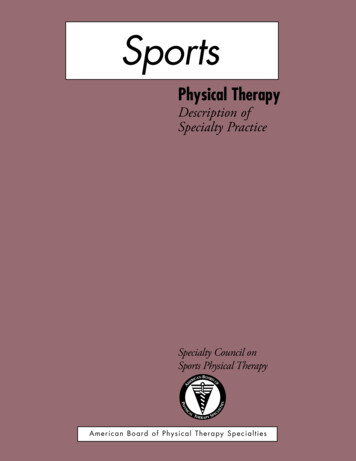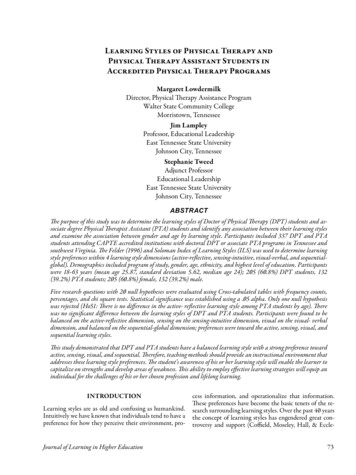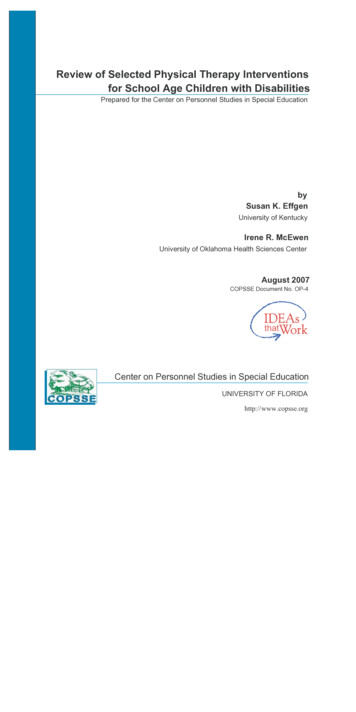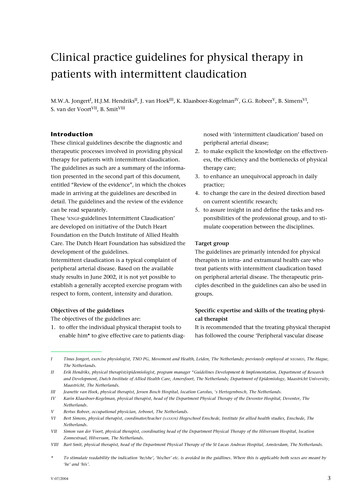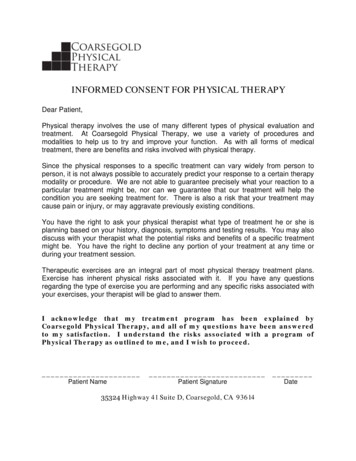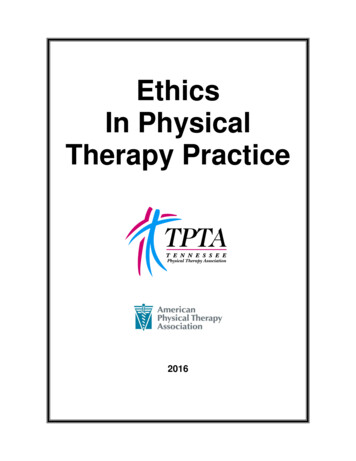
Transcription
EthicsIn PhysicalTherapy Practice2016
Tennessee Physical Therapy AssociationEthics in Physical Therapy PracticeTable of ContentsEthics Slides . 3PT Core Values Self-Assessment . 18PTA Core Values Self-Assessment . 29APTA Code of Ethics . 35APTA Standards of Ethical Conduct for the Physical Therapist Assistant . 37Ethics Cases for Analysis . 39Resources and References . 40Post-test. 41The Code of Ethics for the Physical Therapist and the Standards of Ethical Conduct for thePhysical Therapist Assistant are reprinted with permission of the American PhysicalTherapy Association. This material is copyrighted, and any further reproduction ordistribution is prohibited.
3/18/2016Course ObjectivesETHICS IN PHYSICALTHERAPY PRACTICE Define common bioethical terminology Use the APTA Code of Ethics and APTAStandards of Ethical Conduct for the PhysicalTherapist Assistant as tools for ethicaldecision making Apply the RIPS Model of Ethical Decision-Making to ethical case analysis Demonstrate through case analysis the abilityto identify ethical conflicts and support aresolution to an ethical dilemmaCourse Outline RIPS Model of Ethical Decision-Making APTA Core Values for PTs APTA Values-Based Behaviors for PTAs APTA Code of Ethics APTA Guide for Professional Conduct APTA Standards of Ethical Conduct for theBioethical PrinciplesEnsure the moral person (patient, family,caregiver) has sufficient resources,assistance, and freedom from interferenceto allow them to be a rational, selfdirecting person.Physical Therapist Assistant APTA Guide for Conduct of the PhysicalTherapist Assistant Case DiscussionFour Key Bioethical Principles Beneficence – doing what is best or right Non-maleficence – do no harm Autonomy – informed decisions Justice – fairnessEthical Questions What is the “right” thing to do? How should I behave? What choices do I have? How will my decisions impact my patient,my organization, my profession and thecommunity?1
3/18/2016The Realm-Individual ProcessSituation (RIPS) Model of EthicalDecision-MakingLaura Lee (Dolly) Swisher, PT, PhD;Linda E. Arslanian, PT, DPT, MS; andCarol M. Davis, PT, EdD, FAPTAThe RIPS Model of Ethical Decision-MakingRealmIndividual ProcessEthical SituationIndividual(relationship betweenindividuals)Moral Sensitivity(recognize situation)Conflict(values are challenged)Organizational/Institutional(good of the organization)Moral Judgment(deciding right or wrongactions)Dilemma(right vs. right situation)Societal(common good)Moral Motivation(moral values above othervalues)Distress(right course of actionblocked by a barrier)Moral Courage(implement action)Temptation(right vs. wrong situation)Silence(values are challengedbut no one is addressingit)RIPS - Realm The individual, organizational/institutional,and societal realms are interdependent The complexity of issues increases as onemoves out from the individual realm into theothers Although one realm is typically the mostimportant, every situation has implicationsfor the other realmsRIPS – Individual Process Moral Sensitivity – recognizing,interpreting, and framing ethical situations Moral Judgment – deciding on rightversus wrong actions Moral Motivation – placing a priority onRIPS – Ethical Conflict When values, goals or duties conflict or arechallenged When you aren’t sure which action to take When it isn’t clear what is the best thing todoethical values over other values Moral Courage – implementing the chosenethical action in spite of barriers2
3/18/2016RIPS – Ethical DilemmaRIPS – Ethical Distress When two or more clear principles or values When one knows the right thing to do, butapply but they support mutually inconsistentcourses of actionorganizational constraints make it nearlyimpossible to pursue the right course ofaction When choosing one “good” clearly violatesanother principle or allows a negativeconsequence When you cannot avoid the conflictof two competing principlesRIPS – Ethical Temptation Involves a choice between a “right” and a“wrong” You may stand to benefit from doing thewrong thingRIPS Case Discussion Cases are on the next two slides. Decide which realm, which individualprocess, and which situation apply to eachcase. Discuss the rationale for your choices.RIPS - Silence Ethical values are challenged, but no one isspeaking about this challenge This may be the course taken by anindividual who is experiencing moraldistressHelen L. has just left the office of a localorthopedic surgeon. She had hoped to illustrateher quality outcomes in order to encouragereferrals. Midway through the visit, it became clearthat the physician was unenthusiastic aboutpositive outcomes of her private practice. Helenhad the clear idea that the MD expected some kindof gift – in fact, he almost stated bluntly that hewould need tee times at the exclusive country clubto consider her request. Helen wonders if she isjust being naïve – perhaps she should just “playthe game.”- Swisher, Arslanian, & Davis3
3/18/2016After a lengthy period of rehabilitation, agrateful patient wishes to give a physicaltherapist a gift.Implementing the RIPS Model ofEthical Decision-Making- Swisher, Arslanian, & DavisStep One – Recognize and Define theEthical Issue Gather all the facts available Determine who has an interest in theissue Use this information to help define theStep One – continuedRealm – Individual Organizational / Institutional Societalissues by analyzing the realm, individualprocess, and situationStep One - continuedIndividual Process – What does this ethicalsituation most involve?Step 1 – continuedSituation – Ethical conflict (issue or problem) Moral sensitivity Ethical dilemma – right vs. right Moral judgment Ethical distress Moral motivation Moral courage Ethical temptation – right vs. wrong Ethical silence4
3/18/2016Step 2 – Reflect What are the relevant laws, duties,obligations, and ethical principles? What professional resources (Code ofEthics, Guide for Professional Conduct,Core Values) speak to the situation?Step 2 – continuedWhat are various alternatives for action? Changing one’s own behavior Attempt to change another’s behavior Attempt to effect a change in organizationalpolicies or practices Advocate to change an unjust lawStep 2 – continuedWhat are the possible consequences ofthese actions? Legal Monetary Professional Personal CommunityStep 2 – continuedTest for Right vs. Wrong Issues Legal test – Is something illegal? (Be awareof your Practice Act and the Rules andRegulations that interpret the Act). If so, it isprobably not a true dilemma but a “hardchoice.” Stench test – Does it “feel” wrong? Such as,gut reaction? Front-page test – How would you like this onthe front-page?Step 2 – continuedTest for Right vs. Wrong Issues Mom test – If I were my mother - would I do this? Professional Ethics Test – Does the Code ofEthics, Guide for Professional Conduct for the PT,Standards of Ethical Conduct, Guide for Conductof the PTA, or Core Values prohibit or discouragethe action?If any of these are “positive,” you may bedealing with an issue of right versus wrongand not an ethical dilemma.5
3/18/2016Step 2 – continuedTest for Right vs. Right ParadigmCan you classify the dilemma into one of thefour main right vs. right paradigms? Truth vs. loyalty Self vs. community Short term vs. long term Justice vs. mercyClassifying into a paradigm may help you relateto similar dilemmas & choose a course ofaction.Step 3 – continuedStep 3 – Make a DecisionThree Approaches: Rule-based – follow the rules, duties,obligations, or ethical principles in place Ends-based – determine the consequencesof alternative actions and the good or harmthat will result for all involved Care-based – resolve dilemmas accordingto relations and concern for othersStep 4 – Implement and Evaluate Investigate “Trilemma” Options Implement the plan Is there a third option that addresses the Evaluate the outcomes of the actionquestions and supports both sides in the“right vs. right” dilemma? Can I create a “Win-Win” in this situation?Tools for Ethical Decision Making Honestly assess and learn for the futureProfessionalism in Physical Therapy Core Values for PTs Values-Based Behaviors for PTAs Core Values for PTs Code of Ethics Values-Based Behaviors for PTAs Standards of Conduct for the PTA Guide to Professional Conduct for PTs Guide for Conduct of the PTA Ethical analysis6
3/18/2016AccountabilityAccountabilityis active acceptance of the responsibility for thediverse roles, obligations and actions of thephysical therapist including self-regulation andother behaviors that positively influencepatient/client outcomes, the profession and thehealth needs of society.Compassion/CaringCompassionis the desire to identify with or sense somethingof another’s experience; a precursor of caring.Caringis the concern, empathy, and consideration forthe needs and values of others.IntegrityIntegrityis the possession of and steadfast adherence tohigh moral principles or professional standards.AltruismAltruismis the primary regard for or devotion to theinterest of patients/clients, thus assuming thefiduciary responsibility of placing the needs of thepatient/client ahead of the physical therapist’s selfinterest.ExcellenceExcellenceis physical therapy practice that consistently usescurrent knowledge and theory whileunderstanding personal limits, integratesjudgment and the patient/client perspective,embraces advancement, challenges mediocrity,and works toward development of newknowledge.Professional DutyProfessional dutyis the commitment to meeting one’s obligations toprovide effective physical therapy services toindividual patients/clients, to serve the profession,and to positively influence the health of society.7
3/18/2016Social ResponsibilitySocial Responsibilityis the promotion of a mutual trust between theprofession and the larger public that necessitatesresponding to societal needs for health andwellness.Do I incorporate Core Valuesin my practice? In your handout, you will find a self assessment: Professionalism in Physical Therapy: CoreValues (for PTs) OR Values-Based Behaviors for PTAs Please take 10 minutes to evaluate yourself,using the sample behaviors as indicators.Code of EthicsAPTA Code of Ethics Defines the values or standards of behavior for anorganization Framework for making ethical decisions andsetting forth professional expectations Listing of desirable behaviors - educational toolEight categories ofPrinciples that definethe ethical obligationsof PTs Stamp of professionalism - external symbol Analyzing the profession - setting prioritiesAPTA Guide toProfessional ConductDeveloped by the APTA Ethics & Judicial Committeeas a companion document to the Code of Ethics to: Serve PTs in interpreting the Code of Ethics inmatters of professional conduct Provide a framework to determine the propriety ofAPTA Standards of Ethical Conduct forthe Physical Therapist AssistantEight categories ofStandards that definethe ethical obligations ofPTAsconduct Guide the professional development of PT students8
3/18/2016APTA Guide for Conduct of thePhysical Therapist AssistantDeveloped by the APTA Ethics & Judicial Committeeas a companion document to the Standards of EthicalConduct for the PTA to: Serve PTAs in interpreting the Standards of EthicalConduct for the Physical Therapist Assistant inmatters of professional conduct Provide a framework to determine the propriety ofconduct Guide the professional development of PTA studentsPrinciple 1 & Standard 1Ways we show dignity and respect include: Recognizing our biases Acting respectfully regardless of age, gender,race, nationality, religion, ethnicity ,social oreconomic status, sexual orientation, healthcondition or disability.Principle 2 & Standard 2A physical therapist and physical therapistassistant shall be trustworthy and compassionatein addressing the rights and needs ofpatients/clients.Core Values: Altruism, Compassion, andProfessional DutyPrinciple 1 & Standard 1A physical therapist and physical therapistassistant shall respect the inherent dignity andrights of all individualsCore Values: Compassion and IntegrityPrinciple 1 & Standard 1The Bottom Line:Do your best to keep your personalbiases from affecting patient/clientcarePrinciple 2 & Standard 2Ways we demonstrate trustworthiness andcompassion Providing information in order to make informeddecisions Collaborating to empower patients/clients Providing services that incorporate individualand cultural differences Protecting patient confidentiality9
3/18/2016Principle 2 & Standard 2The Bottom Line:Empower patient autonomy byproviding collaborative andconfidential informationPrinciple 3 & Standard 3Principle 3 - Physical therapists shall be accountablefor making sound professional judgmentsStandard 3 - Physical therapist assistants shall makesound decisions in collaboration with the physicaltherapist and within the boundaries established bylaws and regulations.Core Values: Excellence and IntegrityPrinciple 3 & Standard 3Ways we demonstrate accountability Using objective information and evidence(literature & best practice) Judgments based on scope of practice,competency & expertisePrinciple 3 & Standard 3The Bottom Line:Use of evidence and collaboration withothers to make decisions in thepatient’s best interest Avoiding conflicts of interest Communicating effectively with othersPrinciple 4 & Standard 4Principle 4 & Standard 4A physical therapist and physical therapistassistant shall demonstrate integrity in theirrelationships with patients/clients, families,colleagues, students, other healthcare providers,employers, payers and the public.Ways we demonstrate integrity in relationships Ensure completely truthful information Do not exploit individuals over whom you haveauthority Discourage & report misconduct or abuseCore Value: Integrity Do not engage in sexual relationships withpatients/clients, supervisees or students Avoid verbal, physical, emotional or sexualharassment10
3/18/2016Principle 4 & Standard 4The Bottom Line:Protect vulnerable individuals fromharmful or potentially harmfulbehaviorsPrinciple 5 & Standard 5Ways we demonstrate legal and professionalobligations Comply with laws and regulations Recognize and respect supervisory roles andresponsibilities Protect research participantsPrinciple 5 & Standard 5The Bottom Line:Responsibilities may extend beyondwhat is required by the practice actinto the moral realm to protectpatients, colleagues and societyPrinciple 5 & Standard 5A physical therapist and physical therapistassistant shall fulfill their legal and professionalobligationsCore Values: Professional Duty andAccountabilityPrinciple 5 & Standard 5Ways we demonstrate legal and professionalobligations Report colleagues who are unable to performprofessional responsibilities skillfully and safely Do not abandon patients; provide notice andinformation about alternative care prior todischargePrinciple 6 & Standard 6Principle 6 - Physical therapists shall enhance theirexpertise through lifelong and refinement ofknowledge, skills, and professional behaviorsStandard 6 - Physical therapist assistants shallenhance their competence through the lifelongacquisition and refinement of knowledge, skills andabilities.Core Value: Excellence11
3/18/2016Principle 6 & Standard 6Ways we demonstrate excellence Maintain competence PT shall engage in critical self assessment andreflection on changes in PT practice Engage in lifelong learningPrinciple 6 & Standard 6The Bottom Line:Stay current in knowledge and skills tosupport patient/client care Cultivate and support practice environmentsthat foster professional developmentPrinciple 7 & Standard 7Physical therapists and physical therapistassistants shall promote organizational behaviorsand business practices that benefitpatients/clients and societyCore Values: Integrity and AccountabilityPrinciple 7 & Standard 7Ways we promote beneficial organizationalbehaviors/business practices Promoting and supporting practice environmentsthat encourage autonomous and accountableprofessional judgments Seek deserved and reasonable remuneration Do not accept gifts that appear to influenceprofessional judgmentPrinciple 7 & Standard 7Ways we promote beneficial organizationalbehaviors/business practicesPrinciple 7 & Standard 7The Bottom Line: Fully disclose any financial interests in productsor services recommended to clients Accurate and reflective documentation, codingand charges Refrain from employment arrangements thatAccept responsibility for all actions:support full disclosure; avoidemployment relationships that preventfulfilling responsibilities to patientsprevent fulfilling professional obligations12
3/18/2016Principle 8 & Standard 8A physical therapist and physical therapistassistant shall participate in efforts to meet thehealth needs of people locally, nationally, orglobally.Principle 8 & Standard 8Ways we demonstrate participation Support provision of pro bono services Advocate to reduce health disparities andimprove access to care Avoid over-utilization or under-utilization ofCore Value: Social Responsibilityphysical therapy services Provide public education about the benefits ofphysical therapy and the unique roles of thephysical therapistPrinciple 8 & Standard 8Moral DiscourseThe Bottom Line: Identify and discuss ethical values, differences inPromote services to individuals whoseaccess to healthcare is limited;promote responsible use of physicaltherapy services; educate publicregarding the value of physical therapyCommunication Tips Keep an open mind Accept and understand differences When in doubt, check it out Take the time to talk about talking Create an environment where people feelsafe sharing ideas/opinionsopinion, potential dilemmas and options for actionwith your colleagues, employers, administrators,physicians and others Differences in opinion don’t necessarily mean youare facing an ethical dilemmaReview of Ethical Analysis Gather all the facts Define the situation Who has an interest Identify values andobligations Review alternatives Consider theconsequences Make a decision Carry out the plan Evaluate theprocess Learn for the future13
3/18/2016Discussion of Ethical SituationsPTs and PTAs May FaceCase Discussion Realm(s) – individual, organizational, orsocietal – that are involved Which type of ethical situation is involved –conflict, dilemma, distress, temptation, silence Which PT Principle(s) and/or PTA Standard(s)relates to or assists with options for the case Core values and bioethical principles relevantto the case Offer several options or resolutions to the caseCase Discussion Appoint a spokesperson to give a 2 minutesummary of the case on the itemsdiscussed After reviewing the assigned case, move onto the next one as time permitsCase 2Sara works in a private practice in which there is a profitsharing plan. Her year-end bonus is directly related tomaximizing return visits as they are the most costeffective. Her boss has been heard to say to other staffmembers that they should treat patients to the maximumof their benefits; after all, you can always change thegoals so there is more therapy to do – it just requiresbeing a little creative. She has also been heard toencourage therapists to discontinue treatment early forthose patients with poor reimbursement. Sara isuncomfortable with this situation but is counting on heryear-end bonus.Case 1Rob, a morbidly obese disabled veteran, arrived at anoutpatient clinic, requesting PT services. His doctorreferred him to this clinic because of their greatreputation. Mary, a PT, working in the gym saw Robwalking into the clinic. She called the front deskrequesting they not assign her the patient. The patientwas scheduled two days later for another PT. Ellen, aPTA who works with Mary, overheard the conversationrequesting that the patient not be assigned to her. Ellenknows that Mary is a fitness fanatic and has heard hermake derogatory comments about people who areoverweight. Ellen feels very uncomfortable about thissituation and wonders if she should do anything.Case 3The PT Director of an outpatient clinic is attracted to astaff PTA. The PT and PTA are both married and workon a team treating patients together and typically cotreat the patients. They are observed in the clinicwhispering, flirting, and touching each other at varioustimes throughout the day. The PT and PTA teamcontinued throughout the year working together andmany of their coworkers have talked with each otherabout their displeasure working in the currentenvironment. Mark, a senior staff therapist is a goodfriend of the director and has been silent about thesituation so far. However, the discontent of the staff isincreasing and he wonders if he should do something.14
3/18/2016Case 4Case 5Jim, a PT, works at a private practice that hasa number of clinics throughout the region. Ithas a centralized management structure.One of the top managers calls Jim and askshim to call a previously scheduled new patientto re-schedule an initial evaluation since aVIP/shareholder has been referred to theclinic wants to be seen as soon as possible.Jim is uncomfortable with this request.Lauren, a PT, is the only witness to a patientfall in the clinic gym. The patient has balanceproblems and the PTA, Hal, working with herwas not guarding her. Lauren observes Halplace a gait belt on the patient after the falland before calling for assistance. Lauren isunsure what to do about this situation.Case 6Drew works for a national contract therapycompany and is currently working in a SNFand likes the patient population. He has apatient who is progressing well, but has notyet met all of her goals. Management ispressuring Drew to discharge the patient tohome prior to the time he feels discharge isappropriate. Drew is uncertain what to doabout this situation.How to Report Ethical ProblemsTennessee Department of Health nst-health-care-professionals Complete the downloadable form and submit You may call 1-800-852-2187 for additionalinstructionsHow to Report Ethical Problems TPTA – If the individual is a TPTA member: File a signed, written complaint with the TPTAPresident The president, in collaboration with the ChapterEthics Committee chair, will determine if thecomplaint has merit Complaints with merit are referred to the EthicsCommittee for investigationPost-test The TPTA president notifies APTA of thecomplaint15
PROFESSIONALISM IN PHYSICAL THERAPY:CORE VALUESSELF-ASSESSMENTAmerican Physical Therapy AssociationDepartment of Physical Therapy Education1111 North Fairfax StreetAlexandria, Virginia 22314Copyright 2013 American Physical Therapy Association.Educational institutions may convert this document to online formats without prior permission, but the copyright statement must remain on thedocument. For non-educational use, changes, alterations, commercial use, or CEU course use, written approval from APTA is required. Contactpermissions@apta.org for one of these uses.
2PROFESSIONALISM IN PHYSICAL THERAPY: CORE VALUESIntroductionIn 2000, the House of Delegates adopted Vision 2020 and the Strategic Plan for Transitioning to A Doctoring Profession (RC 37-01). The Planincludes six elements: Doctor of Physical Therapy, Evidenced-based Practice, Autonomous Practice, Direct Access, Practitioner of Choice, andProfessionalism, and describes how these elements relate to and interface with the vision of a doctoring profession. In assisting the professionin its transition to a doctoring profession, it seemed that one of the initiatives that would be beneficial was to define and describe the concept ofprofessionalism by explicitly articulating what the graduate of a physical therapist program ought to demonstrate with respect toprofessionalism. In addition, as a byproduct of this work, it was believed that practitioner behaviors could be articulated that would describewhat the individual practitioner would be doing in their daily practice that would reflect professionalism.As a part of the preparation for this consensus conference, relevant literature was reviewed to facilitate the development of the conferencestructure and consensus decision-making process. Literature in medicine3, 18, 19, 25, 27 reveals that this profession continues to be challenged todefine professionalism, describe how it is taught, and determine how it can be measured in medical education. The groundwork and advancesthat medicine laid was most informative to the process and product from this conference. Physical therapy acknowledges and is thankful formedicine’s research efforts in professionalism and for their work that guided this conference’s structure and process.Eighteen physical therapists, based on their expertise in physical therapist practice, education, and research, were invited to participate in aconsensus-based conference convened by APTA’s Education Division on July 19-21, 2002. The conference was convened for the purpose of:1) Developing a comprehensive consensus-based document on Professionalism that would be integrated into A Normative Model ofPhysical Therapist Professional Education, Version 2004 to include a) core values of the profession, b) indicators (judgments,decisions, attitudes, and behaviors) that are fully consistent with the core values, and c) a professional education matrix that includeseducational outcomes, examples of Terminal Behavioral Objectives, and examples of Instructional Objectives for the classroom andfor clinical practice.2) Developing outcome strategies for the promotion and implementation of the supplement content in education and, where feasible, withpractice in ways that are consistent with physical therapy as a doctoring profession.The documentation developed as a result of this conference is currently being integrated into the next version of A Normative Model of PhysicalTherapist Professional Education: Version 2004. The table that follows is a synopsis of a portion of the conference documentation thatdescribes what the physical therapist would be doing in his or her practice that would give evidence of professionalism.In August 2003, Professionalism in Physical Therapy: Core Values was reviewed by the APTA Board of Directors and adopted as a coredocument on professionalism in physical therapy practice, education, and research. (V-10; 8/03)We wish to gratefully acknowledge the efforts of those participants who gave their time and energies to this challenging initiative; a first step inclearly articulating for the physical therapist what are the core values that define professionalism and how that concept would translate intoprofessional education.
3USING THE SELF-ASSESSMENTThe Self-Assessment that follows is intended for the user to develop an awareness about the core values and to self-assess the frequency withwhich he or she demonstrates the seven core values based on sample indicators (behaviors not intended to be an exhaustive list) that describewhat the practitioner would be doing in daily practice. These seven core values were identified during the consensus-based conference thatfurther defined the critical elements that comprise professionalism. Core values are listed in alphabetical order with no preference or rankinggiven to these values. During the conference many important values were identified as part of professionalism in physical therapy, howevernot all were determined to be core (at the very essence; essential) of professionalism and unique to physical therapy. The seven valuesidentified were of sufficient breadth and depth to incorporate the many values and attributes that are part of professionalism.For each identified core value, (ie, accountability, altruism, compassion/caring, excellence, integrity, professional duty, andsocial responsibility) a definition and sample indicators (not intended to be exhaustive) are provided that describe what the physical therapistwould be doing in practice, education, and/or research if these core values were present.Complete the Self-AssessmentReview each core value indicator and check the frequency with which you display that sample indicator in your daily practice based on therating scale provided (1-5). It is not expected that one will rate himself or herself as 5 (always) or 1 (never) on every item. Be candid in yourresponse as this is a self-assessment process with an opportunity for personal learning and insight, identification of areas of strength andgrowth, and assessment of your development in the professionalism maturation process.Analyze the Completed Self-AssessmentOnce you have completed the Self-Assessment, you may want to reflect as an individual or group on the following questions: On what sample indicators did you or the group consistently score yourself/themselves on the scale at the 4 or 5 levels? Why did you or the group rate yourself/themselves higher in frequency for demonstrating these sample behaviors? On what sample indicators did you or the group score yourself/themselves on the scale at level 3 or below? Why did you or the group rate yourself/themselves lower in frequency for demonstrating these sample
The Code of Ethics for the Physical Therapist and the Standards of Ethical Conduct for the Physical Therapist Assistant are reprinted with permission of the American Physical Therapy Association. This material is copyrighted, an
